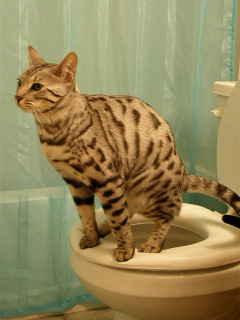Dangers of Flushing Cat Poop Down Your Toilet - Avoid Possible Problems
Dangers of Flushing Cat Poop Down Your Toilet - Avoid Possible Problems
Blog Article
Have you been searching for content about Can You Flush Cat Poo or Litter Down the Toilet??

Introduction
As feline proprietors, it's vital to be mindful of just how we take care of our feline buddies' waste. While it might appear practical to purge feline poop down the toilet, this practice can have destructive repercussions for both the setting and human health and wellness.
Ecological Impact
Flushing feline poop presents damaging virus and parasites right into the supply of water, posing a significant threat to water environments. These pollutants can negatively impact aquatic life and compromise water quality.
Health Risks
Along with ecological problems, flushing feline waste can also position health and wellness dangers to humans. Feline feces may include Toxoplasma gondii, a bloodsucker that can trigger toxoplasmosis-- a possibly serious ailment, particularly for expectant women and individuals with weakened immune systems.
Alternatives to Flushing
Fortunately, there are more secure and more accountable ways to deal with pet cat poop. Take into consideration the complying with options:
1. Scoop and Dispose in Trash
The most common approach of throwing away feline poop is to scoop it right into an eco-friendly bag and throw it in the garbage. Make certain to use a dedicated litter inside story and deal with the waste quickly.
2. Use Biodegradable Litter
Opt for naturally degradable feline trash made from materials such as corn or wheat. These trashes are environmentally friendly and can be safely disposed of in the trash.
3. Hide in the Yard
If you have a yard, consider hiding pet cat waste in a marked location far from vegetable gardens and water resources. Make sure to dig deep enough to stop contamination of groundwater.
4. Set Up a Pet Waste Disposal System
Invest in a pet garbage disposal system specifically created for cat waste. These systems utilize enzymes to break down the waste, reducing odor and ecological impact.
Conclusion
Accountable family pet possession expands past supplying food and shelter-- it also includes appropriate waste monitoring. By refraining from purging pet cat poop down the toilet and going with alternative disposal methods, we can reduce our environmental footprint and secure human wellness.
Why Can’t I Flush Cat Poop?
It Spreads a Parasite
Cats are frequently infected with a parasite called toxoplasma gondii. The parasite causes an infection called toxoplasmosis. It is usually harmless to cats. The parasite only uses cat poop as a host for its eggs. Otherwise, the cat’s immune system usually keeps the infection at low enough levels to maintain its own health. But it does not stop the develop of eggs. These eggs are tiny and surprisingly tough. They may survive for a year before they begin to grow. But that’s the problem.
Our wastewater system is not designed to deal with toxoplasmosis eggs. Instead, most eggs will flush from your toilet into sewers and wastewater management plants. After the sewage is treated for many other harmful things in it, it is typically released into local rivers, lakes, or oceans. Here, the toxoplasmosis eggs can find new hosts, including starfish, crabs, otters, and many other wildlife. For many, this is a significant risk to their health. Toxoplasmosis can also end up infecting water sources that are important for agriculture, which means our deer, pigs, and sheep can get infected too.
Is There Risk to Humans?
There can be a risk to human life from flushing cat poop down the toilet. If you do so, the parasites from your cat’s poop can end up in shellfish, game animals, or livestock. If this meat is then served raw or undercooked, the people who eat it can get sick.
In fact, according to the CDC, 40 million people in the United States are infected with toxoplasma gondii. They get it from exposure to infected seafood, or from some kind of cat poop contamination, like drinking from a stream that is contaminated or touching anything that has come into contact with cat poop. That includes just cleaning a cat litter box.
Most people who get infected with these parasites will not develop any symptoms. However, for pregnant women or for those with compromised immune systems, the parasite can cause severe health problems.
How to Handle Cat Poop
The best way to handle cat poop is actually to clean the box more often. The eggs that the parasite sheds will not become active until one to five days after the cat poops. That means that if you clean daily, you’re much less likely to come into direct contact with infectious eggs.
That said, always dispose of cat poop in the garbage and not down the toilet. Wash your hands before and after you clean the litter box, and bring the bag of poop right outside to your garbage bins.
https://trenchlesssolutionsusa.com/why-cant-i-flush-cat-poop/

Hopefully you enjoyed reading our excerpt on Don’t flush cat feces down the toilet. Thanks so much for finding the time to browse our piece. Feel free to take the time to promote this content if you appreciated it. I recognize the value of reading our article about How to Dispose of Cat Poop and Litter Without Plastic Bags.
Call Today Report this page